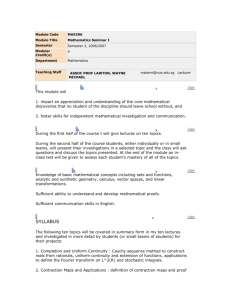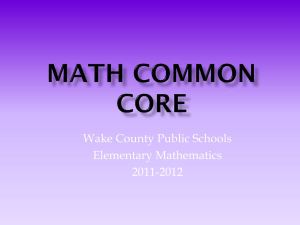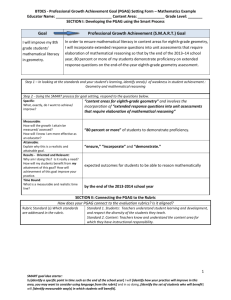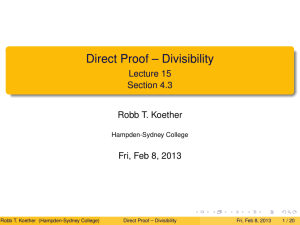doc
advertisement
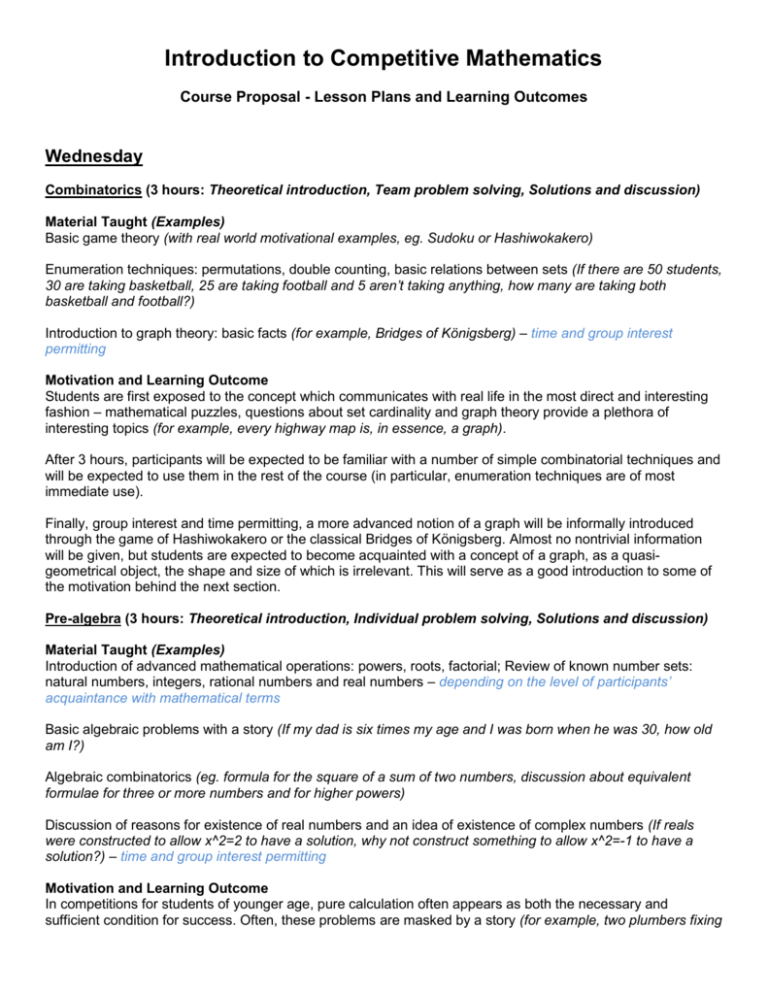
Introduction to Competitive Mathematics Course Proposal - Lesson Plans and Learning Outcomes Wednesday Combinatorics (3 hours: Theoretical introduction, Team problem solving, Solutions and discussion) Material Taught (Examples) Basic game theory (with real world motivational examples, eg. Sudoku or Hashiwokakero) Enumeration techniques: permutations, double counting, basic relations between sets (If there are 50 students, 30 are taking basketball, 25 are taking football and 5 aren’t taking anything, how many are taking both basketball and football?) Introduction to graph theory: basic facts (for example, Bridges of Königsberg) – time and group interest permitting Motivation and Learning Outcome Students are first exposed to the concept which communicates with real life in the most direct and interesting fashion – mathematical puzzles, questions about set cardinality and graph theory provide a plethora of interesting topics (for example, every highway map is, in essence, a graph). After 3 hours, participants will be expected to be familiar with a number of simple combinatorial techniques and will be expected to use them in the rest of the course (in particular, enumeration techniques are of most immediate use). Finally, group interest and time permitting, a more advanced notion of a graph will be informally introduced through the game of Hashiwokakero or the classical Bridges of Königsberg. Almost no nontrivial information will be given, but students are expected to become acquainted with a concept of a graph, as a quasigeometrical object, the shape and size of which is irrelevant. This will serve as a good introduction to some of the motivation behind the next section. Pre-algebra (3 hours: Theoretical introduction, Individual problem solving, Solutions and discussion) Material Taught (Examples) Introduction of advanced mathematical operations: powers, roots, factorial; Review of known number sets: natural numbers, integers, rational numbers and real numbers – depending on the level of participants’ acquaintance with mathematical terms Basic algebraic problems with a story (If my dad is six times my age and I was born when he was 30, how old am I?) Algebraic combinatorics (eg. formula for the square of a sum of two numbers, discussion about equivalent formulae for three or more numbers and for higher powers) Discussion of reasons for existence of real numbers and an idea of existence of complex numbers (If reals were constructed to allow x^2=2 to have a solution, why not construct something to allow x^2=-1 to have a solution?) – time and group interest permitting Motivation and Learning Outcome In competitions for students of younger age, pure calculation often appears as both the necessary and sufficient condition for success. Often, these problems are masked by a story (for example, two plumbers fixing a broken pipe) and thus the solution requires setting up the mathematical statement of the problem properly and then solving it. Students will learn how to approach such problems, separating the irrelevant information in them (it doesn’t matter that they are fixing the pipe) from the relevant (their speed is what matters). In general, this forms a large part of problem solving even in much more complex settings. Finally, students will reapproach the set of real numbers in a setting which invites them to discuss why we want, or indeed need, them to exist. This will give a lesson on questioning the reasons behind rules and definitions, as well as help students understand the concept of complex numbers, which will form a large part of their mathematical education in high school. Thursday Number Theory (3 hours: Theoretical introduction, Individual problem solving, Solutions and discussion) Material Taught (Examples) Divisibility and prime numbers: Fundamental Theorem of Arithmetic (How many positive divisors does the number 30 have?) Concept of relative primality: Euclid’s Theorem, Greatest Common Divisor, Euler function (If there are n numbers on the board, and we always take the largest one and replace it with the difference of that number and any other smaller number on the board, which number will we obtain at the end?) Combinatorial number theory (How many positive integers smaller than 5000 exist, such that they are divisible by 6, but are not divisible by 7?) Introduction to modular arithmetic (eg. comparison with clock arithmetic; Fermat’s theorem) – time and group interest permitting Motivation and Learning Outcome The concept of divisibility (and modular arithmetic) is a fundamental one – classical algebra was, in essence, built as an attempt at generalizing divisibility facts proved for integers (eg. Chinese Remainder Theorem). After the New Math debacle in the 1960s, fundamental concepts rarely make early appearance in education (notwithstanding the recent geometry curriculum in Israel, widely regarded as misguided and subsequently pulled). Hence, the field of number theory is more comprehensively explored in high school competitions, and this section serves merely to provide a taste and motivation for things to come. Students will have been acquainted with the concept of primality and divisibility in school. Those basic facts will be reviewed here, as well as expanded with a number of simple theorems. Some problems with a combinatorial flavour will be approached as well and students will implicitly learn to construct sets of integers satisfying certain properties. Geometry (3 hours: Theoretical introduction, Team problem solving, Solutions and discussion) Material Taught (Examples) Review of basic line and triangle terminology: midpoints, triangle similarity and congruence, medians, altitudes Geometric calculations and basic proofs: “angle chasing”, Pythagorean theorem (eg. having a large drawing of intersecting lines, some of the angles between the lines being known and some to be determined) A review of some open problems in combinatorial, number theoretic or pure geometry (eg. rational triangles) Motivation and Learning Outcome In most mathematical competitions, problems in pure geometry are almost always limited to plane geometry. In fact, almost all of them are based on only three shapes: circles, triangles and quadrilaterals. Hence, those shapes will be emphasized in the course. After reviewing the terminology, some of which the students will have been acquainted with, some of the time will be devoted to techniques in area calculation and angle determination, and proving geometric equalities, the students being expected, for example, to learn to apply their knowledge of the sums of angles of polygons. Finally, from a pedagogical standpoint, the last part of the theoretical introduction is expected to be the most thought-provoking. In the educational system, students are often under the – intended or not – impression that mathematics is a finished field with no open problems. It will be shown, with a variety of examples in geometry, that that is indeed not the case. It is hoped this will serve as a motivation and a take home message to students. Friday Individual Practice Competition (3 hours, including results, solutions and discussion) Material Taught (Examples) Five to eight proof based problems from the four areas listed above Motivation and Learning Outcome As a final element of the course, students will get the chance to participate in a full-blown practice competition. This is both an opportunity for students to apply the skills honed during the previous two days and a learning experience: soft skills such as choosing the order in which to tackle the problem, keeping in mind the time available or writing clearly and in logical order are of immense use in any kind of time-constrained work. The test papers will be immediately marked and the results announced, after which the solutions will be given and explained. Hence, students will go through one entire run of the competition, from first seeing the problems to results and possible appeals. This will provide invaluable experience to those choosing to participate in real competitions later on.




